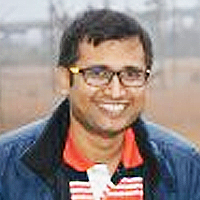Sleep Disorders and Sleep Studies Case Reports
Published on: 11th December, 2024
Sleep disorders represent a significant public health concern due to their widespread prevalence, impact on overall health, and the economic burden they impose. These disorders encompass a broad spectrum of conditions, ranging from insomnia and obstructive sleep apnea (OSA) to narcolepsy, restless legs syndrome (RLS), and parasomnias. They are often associated with comorbidities such as cardiovascular diseases, metabolic dysfunctions, and mental health disorders, making their identification and management critical.The publication of this work is of high interest as it contributes to the expanding body of literature focused on understanding the complex interplay between sleep disorders and health outcomes. By presenting detailed case reports, this study provides valuable insights into the diagnostic challenges, treatment modalities, and potential avenues for personalized interventions in sleep medicine. Case reports are particularly important in this field as they shed light on unique presentations and rare conditions that might otherwise go unnoticed in large-scale epidemiological studies. From an epidemiological perspective, sleep disorders are highly prevalent globally. According to the World Health Organization (WHO), approximately 30% - 45% of the global population experiences sleep disturbances. Obstructive sleep apnea, for instance, affects nearly 1 billion individuals worldwide, with varying prevalence across age, gender, and geographic regions. Insomnia affects roughly 10% - 30% of adults, with rates as high as 50% - 60% in older populations.Meanwhile, narcolepsy, though rare, is estimated to affect 1 in 2,000 people in the general population. These statistics underscore the pressing need for enhanced diagnostic methods, improved treatment strategies, and comprehensive patient management. By detailing real-world cases, this publication aims to bridge the gap between clinical observations and broader scientific understanding. The insights gained from these case studies have the potential to inform future research directions, improve clinical practices, and ultimately enhance patient outcomes in sleep medicine.Sleep disorders affect millions of individuals globally, disrupting physical, mental, and emotional well-being. Conditions such as insomnia, obstructive sleep apnea (OSA), narcolepsy, and restless legs syndrome (RLS) are among the most studied. This paper examines the etiology, diagnosis, and management of sleep disorders, presenting detailed case reports and integrating relevant sleep study findings. Figures such as polysomnography (PSG) outputs and statistical trends provide visual insights into diagnostic and therapeutic interventions. Sleep disorders encompass a wide range of conditions that significantly disrupt sleep quality and overall well-being. Common disorders such as insomnia, obstructive sleep apnea (OSA), narcolepsy, and restless legs syndrome (RLS) affect millions globally, posing risks to physical health, mental stability, and cognitive performance. This study explores the clinical presentation, diagnostic approaches, and management of sleep disorders through the lens of detailed case reports and sleep study data.Polysomnography (PSG), the gold standard for sleep disorder diagnosis, plays a pivotal role in identifying abnormal sleep patterns, respiratory irregularities, and neural disruptions. Multiple sleep latency tests (MSLT) and actigraphy complement PSG, offering insights into disorders like narcolepsy and circadian rhythm abnormalities. This paper presents three representative case reports: chronic insomnia, severe OSA, and narcolepsy with cataplexy. Each case is analyzed in-depth, highlighting patient history, PSG findings, treatment interventions, and outcomes. For chronic insomnia, cognitive-behavioral therapy for insomnia (CBT-I) and pharmacological intervention resulted in marked improvements in sleep latency and efficiency. In the OSA case, continuous positive airway pressure (CPAP) therapy significantly reduced the apnea-hypopnea index (AHI) and alleviated daytime symptoms. The narcolepsy case demonstrates the efficacy of modafinil and sodium oxybate in managing excessive daytime sleepiness and cataplexy.Despite advancements, challenges persist in the field, including patient adherence to therapy, accessibility to specialized sleep studies, and the ethical implications of AI-driven diagnostic tools. Future research should focus on scalable, patient-centric approaches and the role of emerging technologies in enhancing diagnostic accuracy and treatment efficacy. This paper aims to contribute to the evolving understanding of sleep disorders, bridging clinical case insights with the broader implications for sleep health and research.
The Police Power of the National Health Surveillance Agency – ANVISA
Published on: 27th December, 2024
The National Health Surveillance Agency (ANVISA) is a public institution created by Law 9782/1999, which integrates the field of Collective Health and acts in the prevention, control, and inspection of sanitary conditions in various sectors, such as food, health, pharmacies, hospitals, and commercial establishments. Its main objective is to guarantee the protection of public health, ensuring that products, services, and environments comply with established standards, to promote health and preventing diseases. To exercise its inspection and control function, Sanitary Surveillance has the power of sanitary police, which gives it the authority to apply necessary measures and curb practices that pose risks to the health of the population.The performance of the Sanitary Surveillance is fundamental to prevent health risks in any part of society and to guarantee national programs for patient safety. It is also essential to prevent diseases, control risks, and monitor compliance with health standards and specific regulations. The police power of Sanitary Surveillance consists of establishing norms and technical regulations, carrying out inspections and inspections, issuing temporary or permanent interdiction orders in establishments that do not comply with the norms, as well as forwarding complaints to the Public Ministry in cases of crimes against public health. Arrests carried out by Sanitary Surveillance agents are extreme measures and applied in serious situations of risk to public health or when there is repeated disrespect for sanitary regulations. The prohibited establishments have the right of defense and may seek to regularize the situation to obtain the release of activities.The performance of the Sanitary Surveillance has significant impacts on the prevention of disease outbreaks and epidemics. Identifying and correcting inappropriate practices helps to prevent the spread of pathogenic agents and reduce the risk of contagion in collective environments. The institution’s preventive and supervisory activities contribute to reducing risks to the population’s health, preventing disease outbreaks, food poisoning, and the proliferation of pests, among other problems. Finally, the importance of exercising police power with transparency, impartiality, and respect for individual rights is emphasized, always aiming at the collective interest and the promotion of the common good. In summary, Health Surveillance plays an essential role in protecting public health, seeking to ensure that the population has access to safe products and services, contributing to the improvement of quality of life and disease prevention.
Exploring the Potential of Medicinal Plants in Bone Marrow Regeneration and Hematopoietic Stem Cell Therapy
Published on: 31st January, 2025
Blood cell production through hematopoiesis within the bone marrow serves both to maintain blood equilibrium and to respond to tissue injury and infectious demands. Hematopoietic stem cell (HSC) therapy developments have revolutionized medical treatment approaches for anemia leukemia and bone marrow failure caused by chemotherapy or radiation exposure. The therapeutic compounds present in medicinal plants have traditionally supported blood health and researchers now understand these plants could help regenerate bone marrow tissue. The analysis investigates how phytochemicals affect HSC proliferation and differentiation while supporting HSC survival. The medicinal plants Panax ginseng, Astragalus membranaceus, and Curcuma longa receive special attention for their documented ability to enhance hematopoiesis in preclinical and clinical settings. This review examines the challenges that include standardization issues, toxicity concerns, and regulatory barriers alongside future perspectives about combining plant-based therapies with traditional treatments to improve bone marrow recovery and health results.
Hepatic Angiomyolipoma Mimicking Hepatocellular Carcinoma: Another Rare Case Report
Published on: 11th February, 2025
Epithelioid angiomyolipomas (AML) are uncommon mesenchymal neoplasms, belonging to the group of perivascular epithelioid cell neoplasms (PECOMA). Hepatic PECOMA is even rarer. It’s difficult to diagnose in preoperative by imaging, especially when the fatty component is scant or absent. The gold standard for the diagnosis is histologic examination coupled with an immunohistochemical study. Positive HMB45 immunostaining of the myoid cells is a major diagnostic feature. Herein, we report a particular case of hepatic angiomyolipoma in a middle-aged woman with no significant medical past history. The preoperative diagnosis was difficult given the absence of specific clinical manifestations, even the radiologists considered high suspicion of hepatocellular carcinoma. The final diagnosis has been made by post-operative histology coupled with an immunohistochemistry study.
Comprehensive Acceptance Testing and Performance Evaluation of the Symbia Intevo Bold SPECT/CT System for Clinical Use
Published on: 19th February, 2025
Aim: This prospective study reports the acceptance testing of the Symbia Intevo Bold SPECT/CT scanner (Siemens Healthineers), recently installed at SQCCCRC, University Medical City, Muscat, Oman, before its clinical implementation.Materials and methods: The acceptance tests were performed using a Low Energy High Resolution (LEHR) collimator and Technetium-99m (Tc-99m) as the radioactive source, following the manufacturer’s protocols. The tests included physical inspection, peaking and tuning, intrinsic and extrinsic uniformity calibration, intrinsic energy resolution, and planar spatial resolution without scatter. Key performance parameters such as full-width at half-maximum (FWHM), system sensitivity, and count rate performance were evaluated.Results: All critical acceptance tests, including intrinsic energy resolution, energy calibration (symmetric curve), and extrinsic uniformity with the LEHR collimator, were completed and met the required specifications. System sensitivity and count rate performance were within the expected ranges, confirming the system’s readiness for clinical use.Conclusion: The Symbia Intevo Bold SPECT/CT system passed all performance tests successfully. The acceptance testing validated the system’s optimal performance following international standards, ensuring its suitability for clinical operations.
Maximizing the Potential of Ketogenic Dieting as a Potent, Safe, Easy-to-Apply and Cost-Effective Anti-Cancer Therapy
Published on: 3rd March, 2025
The global menace of cancer requires supplementary treatments beyond standard medical approaches for effective medical intervention. The Ketogenic Diet (KD) composed of high fats combined with moderate proteins and low carbohydrates has become popular as a metabolic therapy for cancer. The anti-cancer mechanism of KD works through metabolic stress induction in cancer cells, reduced insulin and IGF-1 signaling pathways, improved mitochondrial function, inflammation, and immune regulation. Standard cancer treatments receive enhanced outcomes through KD synergistic action which simultaneously decreases treatment-related side effects. To achieve optimized treatment outcomes in cancer, ketogenic diet practitioners need to use personalized nutritional planning in combination with metabolic tracking and exogenous ketone supplements. It is essential to find solutions for diet adherence issues and nutrient deficiencies because they determine KD’s effectiveness as a cancer treatment. The fight against cancer needs sustained and multipronged clinical research and validation to establish the proper implementation of this method.
A Comparative Study of Metoprolol and Amlodipine on Mortality, Disability and Complication in Acute Stroke
Published on: 4th April, 2025
Stress in acute stroke may increase mortality and complications, but there is a paucity of information on the efficacy of beta blockers over other anti-hypertensive. To report efficacy of metoprolol over amlodipine in reducing mortality, disability and infections in acute stroke. CT/MRI confirmed stroke patients within 3 days of onset were included whose age was 18 to 75 years. Patients with secondary intracerebral hemorrhage, organ failure, pregnancy, malignancy, and immunosuppressant or on beta-blocker/amlodipine were excluded. Stroke risk factors, Glasgow Coma Scale (GCS) score, National Institute of Health Stroke Scale (NIHSS) score and CT/MRI findings were noted. Patients with a blood pressure of > 160/90 mm of Hg were randomized using 1:1 randomization to metoprolol (25 mg on day 1, 50 mg if BP is not controlled) or amlodipine (2.5 mg on day 1, then 5 mg then 10 mg on, subsequent days if BP is not controlled). Other standard treatment was continued. The primary outcome was mortality at 1 month; secondary outcomes included were in-hospital gastrointestinal hemorrhage, pneumonia, sepsis and 3 months functional outcome based on modified Rankin Scale (mRS). Side effects were noted. 18 (14.4%) patients died; 6 (9.7%) in metoprolol and 12 (19%) in amlodipine (p = 0.20) group. At 3-months, 66 patients had good outcome; 45 (80.4%) in metoprolol and 21 (43.3%) in amlodipine group (p < 0.001). The other secondary outcomes were comparable between the two groups. Metoprolol was withdrawn in 6 patients due to bradycardia, and amlodipine in 5 due to hypotension and in 1 due to allergic reaction. Metoprolol is associated with improved functional outcomes in acute stroke compared to amlodipine.
Success Rate and Complications of Endoscopic Deacryocystorhinostomy without Stenting: A Retrospective Study
Published on: 16th April, 2025
Endoscopic dacryocystorhinostomy (EDCR) is a well accepted surgical treatment for patients with nasolacrimal duct obstruction (NLDO). Previously, external dacryocystorhino-stomy was considered as the gold standard treatment for NLDO, however, EDCR has gained momentum due to its several advantages. The EDCR has been sounding more aesthetic and as functional compared to the traditional external dacryocystorhinostomy in the surgical treatment of nasolacrimal duct obstruction with comparable outcomes. Purpose: to determine the success rate and complications of endoscopic dacryocystorhinostomy without stenting.Materials and methods: it was a retrospective study performed in the department of Otorhinolaryngology and Head and Neck Surgery (ORL-HNS), Universal College of Medical Sciences-Teaching Hospital (UCMS-TH) from June 2019 to September 2024. A total of 19 patients charts were reviewed. All the cases were performed under general anesthesia. All the cases had undergone without silicon stenting and were regularly followed up for a period of 3 months. Post operative stomal patency and complications were noted based on subjective and endoscopic evaluation.Results: Out of 19 patients, 12 were female and 7 were male with the age range of 12 to 70 years. Transnasal synechiae was seen in 2 female and 1 male patients. Stomal patency was 100% with no recurrence of epiphora in 17 patients (89.4%) during 3 months of follow up. 2 female patients with released synechiae didn’t come for 3 months follow up.Conclusion: It is a safe and minimally invasive procedure and has a comparable success rate to external DCR with an additional advantage of more aesthetic value.
















